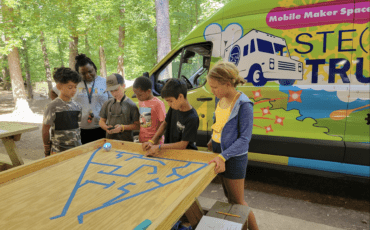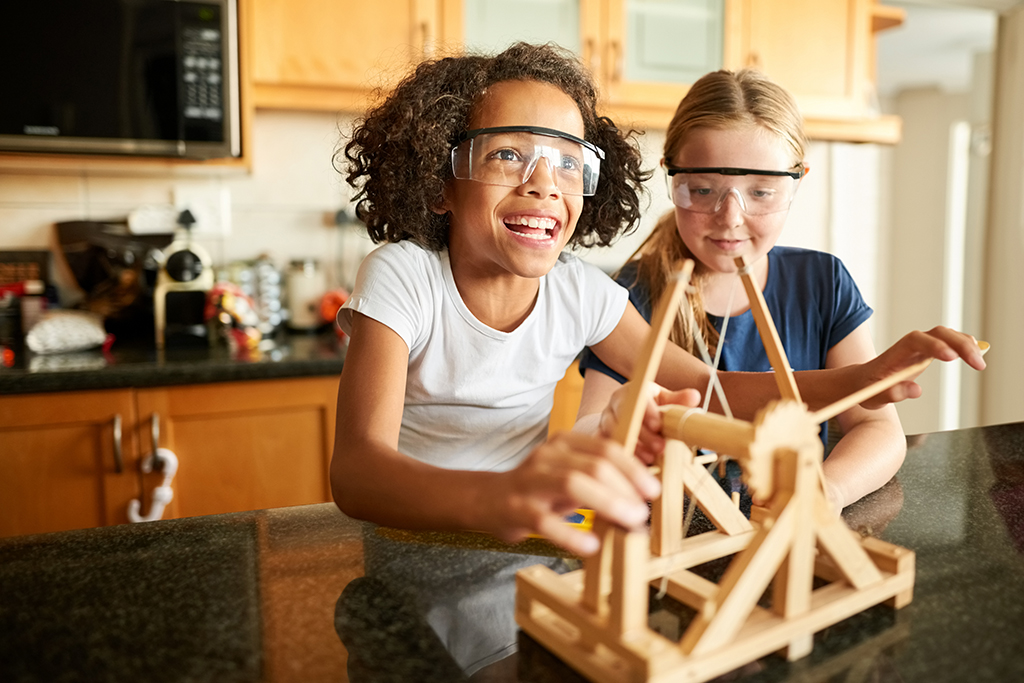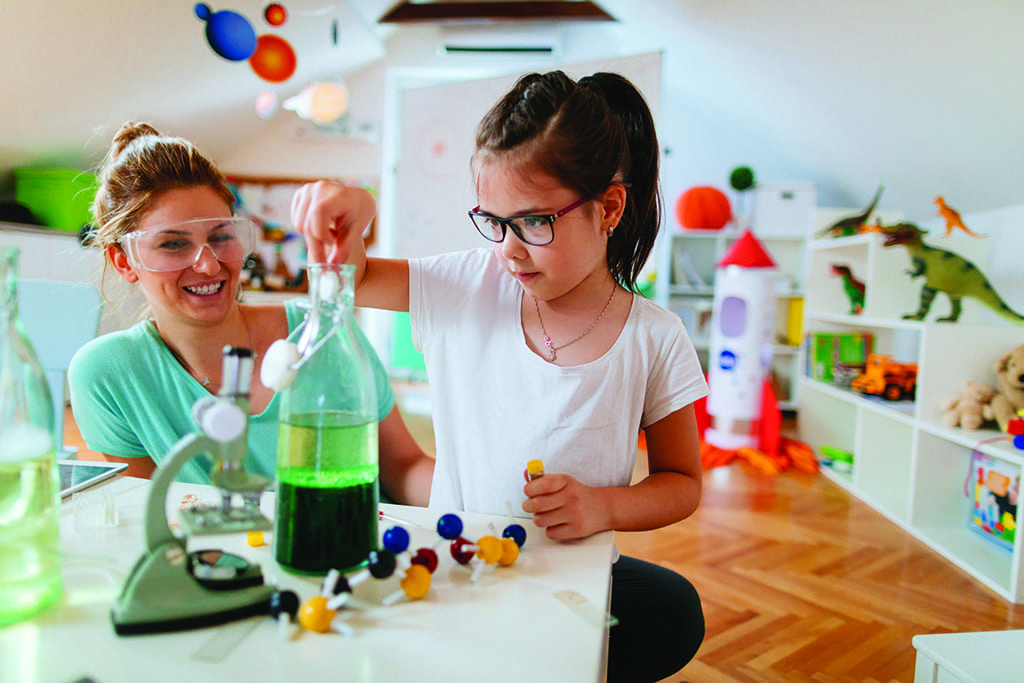30 Science Experiments You Can Do at Home with the Kids

These experiments are an exciting way to teach science and entertain your kids no matter their age.
Ages 3-5
Make a glitter volcano with glitter, baking soda, dish soap, vinegar, cups and pipettes. Watch as the volcano erupts with glitter!
Explain afterimages with these colorful experiment. Look at the image on the monitor or print out the image on a color printer. Look at the image of the colored circle, focusing on the center, for 30 seconds. Then look at the white space next to it. With the afterimage, you’ll see the same size and shape of the image, but the colors have changed.
Make a candy rainbow with hard-shelled colored candies, a plate, glass or measuring cup, warm water, dish or paper towels, spoon and sugar. Arrange candy in a circle around the inner rim of the plate. Pour warm warm into the middle of the plate and watch what happens. On a dry plate, make a circle of candy, placing about a quarter tsp. of sugar in the middle of the plate. Pour warm water near the center of the plate (not directly on the sugar) and watch what happens.
Mix up yogurt silly putty for a fun way to play. Mix together 1 c. of yogurt (without fruit chunks) and ¾ c. corn starch. When it’s no longer sticky, pick it up and roll it into a ball, and then start playing.
Explain density with this easy oil and water experiment. Fill a container with vegetable oil, and fill several small containers with water and food coloring. Using pipettes, suck up the colored water. Insert the pipette into the oil and slowly release a ball of colored water, showing kids that oil and water don’t mix.
Explain gravity and how it can be changed using strong magnets. Tie paper clips to pieces of string to show how the paper clips hang from the string, pulled by Earth’s gravity. Set up a ruler with magnets to show how it disrupts natural gravity.
Create salt crystals using water, salt, glass bowls, food coloring and a magnifying glass. Dissolve salt in the glass of water. Pour the salt water combination into bowls and add food coloring. Put the bowls in a warm place so the water evaporates quickly. Once the water has evaporated, use a magnifying glass to look at the crystals.
Make your own bouncy balls with white glue, food coloring, Borax powder, corn starch and warm water. In a cup, pour together the water, corn starch and Borax. In another cup, pour the glue. Put food coloring into the glue and stir together. Mix the water, corn starch and Borax together before pouring the mixture into the colored glue. Stir together until you have a glob, and then roll together with your hands until you have a ball.
Replicate rain and clouds with shaving cream, food coloring, clear glasses, small bowls, water and an eye dropper. Fill small containers with water and add food coloring to each of the containers. Fill a clear glass with water about ⅔ full and top with shaving cream in the shape of a cloud. Using the eye dropper, drop the different colors on the shaving cream cloud and watch as the “rain” falls.
Make toothpaste fit for an elephant with a plastic water bottle, yeast, warm water, liquid dish soap, hydrogen peroxide, cup, spoon, googles and a tray. Pour the hydrogen peroxide into the water bottle, fill cups with warm water and put liquid dish soap into separate cups. Pour the yeast into the warm water, stirring for about 30 seconds. Pour the dish soap into the peroxide and mix together, swirling gently. Add the warm water and yeast to watch the foaming mixture grow.
Ages 6-9
Make invisible ink to write secretive letters using a lemon, paper, a spoon, a bowl, cotton bud and light bulb. Squeeze lemon juice into a bowl. Write a message onto the white paper with the cotton bud. Once it dries, it will become invisible, and you’ll only be able to see it under the light.
Watch color move with capillary action using seven glasses, water, food coloring and paper towels. Line the seven glasses up, filling glasses 1, 3, 5 and 7 with water. Add red food coloring to glass 1 and 7, yellow food coloring to glass 3 and blue food coloring to glass 5. Take a paper towel and fold in half width wise and fold three more times. Put one side of the paper towel in each glass, repeating until all seven glasses have a paper towel. Watch as the water and colors move along the line of glasses.
Make homemade butter using 1 pint heavy whipping cream, a mason jar, ⅛ tsp. salt and marbles. Pour the cream halfway in the mason jar, and you can add clean marbles to make the butter more quickly. After securing the lid, take turns shaking continuously. When you hear a difference in the shaking, open the container and add salt. Keep shaking until the butter is a solid mass.
Create non-Newtonian fluid Oobleck with water, corn starch and food coloring. Mix the water and corn starch together before adding the food coloring. It’s ready to play with, and the mixture will act both like a liquid and like a solid. You can also make it glow-in-the-dark.
Launch marshmallows using popsicle sticks, rubber bands, a plastic Easter egg, marshmallows, cardstock and tape or glue. Take a rubber band and wrap it around a popsicle stick. Place the stick perpendicular to a second stick. Stack nine more sticks on top of the second one. Wrap a rubber band around both sides of the stack. Pass a rubber band through the holes on the Easter egg shell. Place the popsicle stick on top of the egg and wrap the rubber band around the stick. Assemble the two pieces together, and you can create targets, or aim for small items or certain parts of the wall.
Create a water tornado using two plastic soda bottles, water and a timer. Fill the soda bottle with water, and dump the water into an empty bowl, timing how long it takes to empty the bottle. Fill the bottle again, but this time when you empty it, move the bottle in a tight, clockwise or counterclockwise circular motion. Keep moving the bottle like so until the water forms into a vortex.
Clean old pennies with vinegar, liquid soap and paper cups. Have your kids guess which liquid will clean the pennies. Put a penny in each paper cup, and pour vinegar in one cup and liquid soap in the other cup to cover the penny. After 10 minutes, remove the pennies rinse them in water and rub them with a paper towel. You can also do this experiment with other acidic liquids.
Find your eye’s blind spot with cards or stiff paper, black marking pen and a yard stick. Mark a dot and a cross on the card. Hold the card about an arm’s length away. Close your right eye and look directly at the cross with your left eye. Focus on the cross, but stay aware of the dot, as you slowly bring the card toward your face. Try to pinpoint when the dot disappears and reappears. Do the same thing, closing your left eye and looking directly at the dot with your right eye.
Play with pepper and soap using a shallow bowl, water, pepper, dish soap, a toothpick, paper and a pencil. Fill the bowl with about an inch of water. Sprinkle pepper along the surface. Squeeze a tiny bubble of dish soap onto a clean counter. Touch the toothpick to the dish soap. Have the kids guess what will happen when you put the soap in the water before putting the toothpick right into the center of the water.
Design a parachute with a plastic bag, scissors, string and a small object. Cut out an octagon from the plastic bag and cut a small hole near the edge of each side. Attach pieces of string the same length to the holes. Tie the strings to the object you’re using as a weight. Drop the parachute from a high spot to see how well it worked.
Ages 10-13
Demonstrate balance with a candle seesaw. Using identical birthday candles, tape, a needle, aluminum foil, a knife, two glasses and a lighter, tape the candles together at the ends, so both wicks are facing opposite directions. Push the needle all the way through the candle in the middle, placing the candle in the gap between the glasses. Light both candles, with a few seconds in between, observing what happens to the movement of the candles.
Make s’mores using a pizza box solar oven with a pizza box, pencil or pen, ruler, white glue, black paper, utility knife, aluminum foil, plastic wrap, shipping or black electrical tape, a wooden skewer, graham crackers, marshmallows and a chocolate bar. Using a utility knife and a ruler, cut a square into the pizza box that is 1″ away from each edge on three of the sides. Line and glue the inside of the flap with aluminum foil. Cover the opening in the lid with a layer of plastic wrap and tape to the box. Cover the entire interior with foil, gluing the foil in place. Glue or tape a sheet of black paper to the bottom of the box in the center. Tape a wooden skewer or pencil to prop the solar oven’s lid up at a 90º angle. Place your s’mores on an aluminum foil tray and put it on the black paper in the solar oven for 30 minutes in full, direct sunlight.
Have the kids build their own Rube Goldberg machine, a complex contraption designed to achieve a simple task. These machines help your kids understand STEM concepts. Get inspired with this video.
Observe the uniqueness of fingerprints with these activities. Using clay, have each of the family members press one of their fingers into it to create a print. With a magnifying glass, make observations about the prints. Put baby powder, flour or powdered sugar on your finger. Press the powdered finger onto clear tape to view your fingerprint. You can also find fingerprints on commonly touched surfaces with baby powder and a makeup brush.
Instant freeze water using a cooler, ice, rock salt, water, unopened plastic bottles of water and a thermometer. Fill the cooler half full of ice, measuring the temperature. Add water slowly until you have 2-3 times as much ice as water, measuring the temperature again. Add rock salt, about 2 c. for each 10 lb. of ice. Mix thoroughly and measure temperature again. Let the bath cool for about 30 minutes, measuring the temperature occasionally, until it’s 22-27ºF. Place the bottles in the bath and leave them to cool. After two hours, the bottles will be the same temperature as the bath, supercooled below the normal freezing temperature. Instantly freeze the bottle by holding it by the neck and tapping onto the bottom with your other hand, watching the ice crystals grow.
Make your own lava lamps with a bottle, vegetable oil, water, food coloring and alka-seltzer. Fill the bottle most of the way with vegetable oil, filling the rest with water. Add a few drops of food coloring, coloring the water. Break an alka-seltzer tablet into a few pieces, dropping them into the bottle one at a time. As the reaction slows down, add more tablets.
Make jello lenses with gelatin dessert (light-colored), water, round measuring spoons and cups, a paper towel and a cutting board. Heat the water in a microwave. Pour the gelatin powder in a bowl, and pour the hot water over it. Mix together for two minutes. Let cool for 10 minutes. Cover the cutting board with a paper towel. Scoop out the liquid with measuring spoons, placing on the paper towel. Move cutting board to the fridge and let sit for four hours. Remove lenses from the spoons. Place the lens on a glass plate or bowl, and move around to use as a magnifying glass.
Create a potato battery using potatoes, galvanized nails, pennies, alligator clip connectors and an LED clock. Insert a nail about 1″ into the potato, writing a minus sign, and push a penny into the opposite end, writing a positive sign. Do this to all of your potatoes. Connect the potatoes so the pennies are attached to the nails. Open the battery in your clock, looking for the plus and minus signs. Connect the nail to the negative terminal inside the battery compartment of the clock, and the last penny to the positive terminal inside the battery compartment.
For the Harry Potter fan, have a potions class, experimenting with Polyjuice Potion, Veritaserum and you can make your own Butterbeer.
Extinguish a candle with this invisible extinguisher. Place tea lights in a short drinking glass, lighting the candles. Pour vinegar into a tall glass. Slowly sprinkle baking soda into the glass with vinegar, and let the reaction slow down until the foam has disappeared. Slowly tilt the tall glass on it’s side over the tea light, as if you were pouring the air over it, and the flame will go out.
For more online science resources, as well as other subjects, check out our list.




